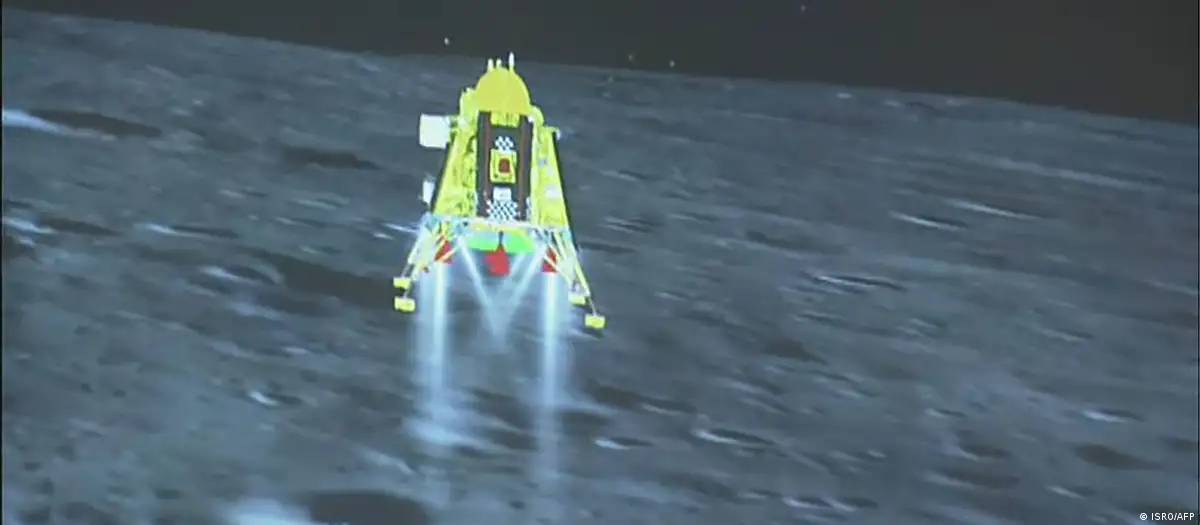SCIENCEGLOBAL ISSUES
Land or crash: Getting to the moon is no mean feat
Zulfikar Abbany
6 hours ago6 hours ago
From Russia’s Luna-25 to India’s Chandrayaan-3 to future NASA-ESA Artemis missions, moon landings are risky — the same as it was for Apollo 11 in 1969.
https://p.dw.com/p/4VP5p
Screengrab from the live feed of India’s Chandrayaan-3 lander touching down softly on the moon
Third time lucky to pull off a first? India’s Chandrayaan-3 becomes the first human spacecraft to land at the moon’s south poleImage: ISRO/AFP
The Americans landed people on the moon in 1969 with less computing power than our contemporary phones. So, why do we find it so hard to land on the moon today?
Heard that before? We have. It’s become one of those irritating cliches that contain an element of truth. It’s also a question that deserves an answer, with Russia, India, the United States, China, Japan and Israel all racing to get to the moon again — sometimes within a week of each other.
On August 23, India became one of only four countries to have successfully landed on the moon when Chandrayaan-3 reached the moon’s south pole. No other country has ever landed at the south pole, a region thought to hold ice water and other valuable resources, so it was a win-win-win for India.
That came just days after Russia’s Luna-25 crashed into the moon, also in an attempt to reach the South Pole.
Russia’s Soyuz rocket has been one of the most reliable over decades of space exploration, and the basics of the technology are the same as they ever wereImage: Sergei Savostyanov/TASS/dpa/picture alliance
Moon landings: You can’t take anything for granted
Our engineering and technology — “rocket science,” if you will — has developed in the 50+ years since the Cold War space race, when Neil Armstrong and Buzz Aldrin became the first people to walk on the moon.
And we have new players in space, more spacefaring nations, including India, with its Chandrayaan missions and regular satellite launches, and the UAE venturing to Mars. China has even landed on the far side of the moon.
But we’ve not seen the same level of technological improvement across the board, even with the advent of sustainable rockets.
“Compared to the Apollo era, navigation technology is much more advanced today. Our on-board sensors allow for more precise and autonomous calculation of position and velocity, on-board computers are much faster, and advanced interfaces increase the situational awareness of ground and on-board crews alike,” said Markus Landgraf, Senior System Architect and Moon Future Studies Team Lead at ESA’s European Space Research and Technology Center in the Netherlands.
Spaceflight is not only about computing power, however. “Rocket engine technology has advanced since the 1960s, mainly in terms of performance due to better materials and understanding of the hydrodynamics and combustion processes. But while computers are many times faster than 50 years ago, the efficiency of rocket engines has increased only by 10 to 20%,” said Landgraf.
We celebrate Apollo 11 as the first time we landed people on the moon, but forget that it took 10 other missions before it, including Apollo 1, which ended in fatal disasterImage: NASA/Zuma/picture alliance
Moon rockets: We understand the risks better
Our technology has improved, as has our understanding of the risks — particularly those in actual rocket science.
“In the 60s and 70s, we simply didn’t understand the risks we were taking. Today, we have a better handle on those, but to overcome them, we add complexity to the solution. But complexity makes it easier to miss a mistake and for ‘anomalies’ to occur,” said Malcolm Macdonald, a professor of spacecraft engineering at Strathclyde University, Scotland.
That’s why we test rockets before we put people in them. We have learned from disasters such as the fire that broke out in the cabin of NASA’s Apollo 1 moon mission in 1967.
“Modern spacecraft are far more complex [now], which both drives up the cost of development and testing, but also the risk of overlooking something,” said Macdonald.
Moon landings are still risky: Craters and boulders
But the moon remains a perilous place to land because of all the craters and boulders that make its surface uneven and unpredictable.
A 2020 study put the number of known craters at close to 140,000, ranging from 1 (0.62 miles) to 8 kilometers in diameter, and others hundreds of kilometers in diameter, often incredibly steep. Then there are the boulders.
“[L]anding on the moon is still difficult. It requires deep experience in the lunar environment,” said Landgraf.
There are better maps available now, but nothing beats being there. Craters and boulders pose in-situ threats that need to be assessed as you attempt a soft landing — that is, surviving, not crashing, like Russia’s Luna-25.
Luna-25 aimed to be the first to land at the moon’s south pole
Russia’s Luna-25 mission aimed to land at the Boguslawsky Crater, which is about 95 kilometers (59 miles) in diameter and at the south pole.
The moon’s south pole is thought to have deposits of ice water and possibly other resources necessary for any humans to live and work on the moon and return to Earth. It’s a region worth investigating.
In 2014, researchers conducted a safety study of landing sites at the Boguslawsky Crater. They found slopes of 5-10 degrees and other, more dangerous, slopes of about 45 degrees, and “more than 16,000 boulders between [about] 0.5 meters up to 13 meters in size” in an area of 4 square kilometers.
So, there was fairly detailed information almost 10 years ahead of the mission. And yet the first thing that Yuri Borisov, the head of the Russian space agency Roscosmos, said after Luna-25’s August 11 launch was that they would have to look for an ideal place to land.
But as it came into land, Roscosmos says the spacecraft “moved into an unpredictable orbit and ceased to exist as a result of a collision with the surface of the moon.”
Of Russia’s (including Soviet Russia’s) 14 “Luna” landing missions, seven have landed and seven have failed.
India has become a major player in space, with regular satellite launches and its attempts to be the first to land a spacecraft at the moon’s south poleImage: various sources/AFP
The moon is back in our sights
After 50+ years of seeming inaction, we are seeing a series of new moon missions but also a string of failures.
In 2019, Israel attempted its first moon landing — Beresheet — and failed.
The same year, India’s Chandrayaan-2 attempted to reach the moon and land a probe called Vikram at the south pole but failed.
And in April 2023, Japan’s Hakuto-R also failed to land, apparently because it ran out of fuel.
“The Hakuto-R and Chandrayaan-2 [failures] both originated — roughly speaking — from improper or incomprehensive testing campaigns, potentially caused by cost reduction measures,” Landgraf said.
But no one is giving up, and India’s successful soft landing at the south pole will no doubt inspire other nations to lift their game.
Closely behind are NASA and its European partners, who have gotten closer with their own Artemis program, recently attempting a test launch of SpaceX’s Starship rocket — which failed. So, room for improvement there.
Edited by: Steen Kristian Gilbertson
This article was originally published August 21, 2023, and updated August 23, 2023.
Russian lunar lander crashes into the moon
02:41
Zulfikar Abbany Senior editor fascinated by space, AI, the mind, how science touches people, European perspectives






























